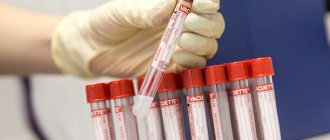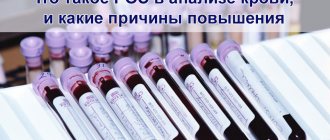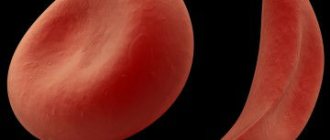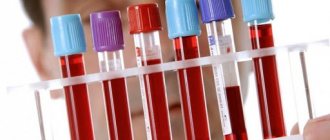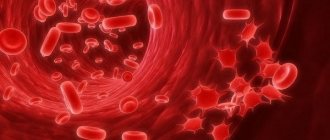Reasons for the increase
Most often, deviations of the sedimentation index from the norm indicate the development of a disease, but in some cases its increase is associated with natural causes. These include:
- Long-term treatment with certain pharmaceutical drugs.
- Pregnancy. An elevated COE is considered normal in this condition.
- Lack of iron in the body. As a rule, this is observed with poor absorption of iron.
- Ages from 4 to 12 years. In children of this age group, who do not have pathology or inflammation, the ESR often increases. It has been noted that this feature is most common in boys.
- Individual body features. According to statistics, 5% of people experience accelerated erythrocyte sedimentation in the absence of any pathological processes.
Pathological causes of changes in sedimentation rate include:
- Development of rheumatism.
- Temporal arteritis.
- Systemic lupus erythematosus.
- Glomerulonephritis.
- Pyelonephritis.
- Nephrotic syndrome.
- Anemia.
- Tuberculosis.
- Hepatitis.
- Operation.
- Inflammation of the gallbladder and pancreas.
- Inflammatory processes in the respiratory tract.
- Oncological diseases.
The harmful activities of viruses, bacteria, parasites and fungi in the body cause the red blood cells to clump together, and the particles formed as a result of their clumping promote the deposition of red blood cells under the influence of gravity.
General information
Determination of ESR is required if acute inflammation or cancer is suspected. The test is also used to diagnose infectious diseases and evaluate the effectiveness of their treatment.
erythrocyte sedimentation rate
analysis data are generally not used in preventive screening programs. It is prescribed only if indicated. Short-term abnormalities in red blood cell counts may indicate the presence of disease, but are often explained by physiological processes. They return to normal without special treatment. Therefore, a violation of ESR when other blood parameters are normal in most cases does not signal the presence of a disease. If necessary, the patient is under the supervision of a doctor and after a certain time the test is repeated to make sure there is no pathology.
Normal indicators
The norms depend on the age and gender of the person. So, in women the normal erythrocyte sedimentation rate is 3-15 mm/hour, and in men 2-10 mm/hour.
In children under 6 months of age, the subsidence rate should be from 12 to 17 mm/hour. In pregnant women, the rate ranges from 20-25 mm/hour, and in people over 60 years old - 15-20 mm/hour.
According to statistics, 40% of deviations from the norm are the result of infectious diseases, 23% of patients with elevated normal values suffer from cancer, 17% of patients have rheumatism, and 8% of patients have anemia, diseases of the intestines, and pancreas. , prostatitis and diabetes.
How to reduce ESR in the blood at home
Erythrocyte sedimentation rate is an indicator that increases with inflammation caused by infection, disintegration of a malignant tumor, or an allergic reaction. To reduce ESR, you need to find how the inflammatory process arose and treat the disease that caused the deviation of this indicator in a general blood test from the norm.
In infectious diseases, high ESR values in a blood test are explained by the active production of antibodies to antigens of viruses, bacteria, and fungi. In the blood in response to infection:
- the concentration of immunoglobulins (Ig) increases;
- the concentration of leukocytes and lymphocytes increases;
- decay products of one’s own cells and fragments of destroyed bacteria, viruses, and fungi appear;
- toxic waste products of pathogenic microorganisms accumulate.
All these changes affect the physical and chemical characteristics of the blood, which leads to an increase in ESR. Thus, in case of an infectious disease, a sharp increase in ESR already 1-2 days after the onset of clinical symptoms is an indicator of the activity of the immune system and does not require any special lowering measures.
After recovery and disappearance of the pathogens, the concentration of Ig and other proteins involved in inflammation will decrease, and ESR levels will normalize. On average, it takes 2-3 weeks to restore ESR after an infection, but sometimes this process can last 1 month or more.
The period of decrease in ESR after illness depends on the type of infection and the severity of the disease.
Thus, after tuberculosis, ROE can return to normal within 2 months after recovery. With mycoplasmosis, ESR can rise to 60 mm per hour, and with parainfluenza it rises slightly and quickly returns to normal.
In infectious diseases, the erythrocyte sedimentation rate naturally decreases after recovery. To help antibiotics, anti-inflammatory drugs, antimycotics, and antiviral drugs that treat infections, medicinal plants with anti-inflammatory properties are additionally used.
Plants such as:
- raspberries - leaves, green branches, fruits, flowers;
- yellow clover;
- marsh cinquefoil;
- chamomile;
- linden - flowers;
- calendula - flowers;
- coltsfoot.
How to lower ESR with anemia
Anemia is a condition in which the level of hemoglobin in the blood and, often, the number of red blood cells in the blood decrease. These changes are accompanied by an increase in ESR.
Iron deficiency anemia with elevated ESR often develops in women during pregnancy. After childbirth, this indicator returns to normal. If this does not happen within 2 months, then you should look for the cause of the increase and treat the disease that caused the increase.
Anemia can occur in a latent form. In this condition, the level of iron and hemoglobin in the blood may be within normal limits, but tissue iron stores are depleted. To identify hidden anemia, a transferrin test is performed.
With a decrease in iron reserves in tissue “depots”, hemoglobin and red blood cells decrease, and ESR increases. To reduce ESR in case of anemia, you need to undergo a medical examination, get a doctor’s recommendations on what medications to take, what to eat, so that the blood test results return to normal.
Recipes for lowering ESR
To increase hemoglobin in the blood and lower ESR in case of anemia in women, you can resort to such a folk remedy as stewed juice of black radish, beets and carrots. To prepare it you need:
- 0.5 liters of freshly squeezed radish, beet and carrot juices are poured into a saucepan and placed in a preheated oven;
- keep warm for 1 hour;
- drink 2 tablespoons 20 minutes before meals 3 times a day;
- course of treatment is 2-3 months.
Such a well-known vegetable as beets will help reduce ESR in a blood test at home. It has proven itself to be an excellent treatment for anemia, and beets are useful both raw and boiled. This vegetable increases hemoglobin in the blood, which in case of anemia helps to reduce ESR.
Recipe with boiled beets
The beets are boiled after first washing them, but not peeling them. To prepare a daily portion of the product you will need 3 small root vegetables and 3 hours of time. The initial volume of water in the pan is 3 liters.
To lower ROE in the blood, use both boiled beets and a decoction. Boiled beets are eaten throughout the day, used in salads, first and second courses.
The decoction is drunk on an empty stomach, 50 ml. The product can be stored in the refrigerator for several days. But it is better to prepare a fresh decoction every time in the evening.
You can be treated with a decoction for a week or more. This remedy has no contraindications, and the benefit of consuming the root vegetable is not only a decrease in ESR, but also an improvement in the functioning of the digestive system.
Recipe with lemon and garlic
- Mix the juice of 2 lemons with grated garlic (2 heads);
- store the mixture in the refrigerator;
- Take a teaspoon twice a day after meals.
Herbal infusion with honey
A tasty folk remedy that can be drunk with both honey and sugar will help reduce ESR in the blood. To prepare the composition you will need:
- coltsfoot;
- Linden;
- chamomile.
The flowers of these plants are taken in equal parts and mixed well. To prepare tea, one tablespoon of raw material is enough, which is poured with boiling water and left to steep for 40 minutes.
Medicinal herbs
Medicinal plants that are used in mixtures, brewed like tea, 1 tablespoon each, have an anti-inflammatory effect:
- licorice, coltsfoot;
- chamomile, calendula.
Methods for reducing ESR
There is only one way to reduce the number of red blood cells: treat the disease that caused them to increase.
Self-administration of antibiotics, dietary supplements and anti-inflammatory drugs is under no circumstances recommended, since each disease requires an individual approach to treatment. It should be remembered that only a doctor can make the correct diagnosis.
To determine the cause of exacerbation of SLE symptoms, a comprehensive examination of the patient is necessary. Once diagnosed, your doctor will explain how to reduce the level of SLE in your blood by prescribing appropriate treatment, and you will be referred for a follow-up test within a few days. If the indicator begins to decrease, albeit slowly, the prescribed treatment gives positive results.
Reducing ESR with medications
- If it turns out that the cause of increased SLE is anemia, the first step is to increase the hemoglobin level. To do this, include foods containing folic acid, vitamin B12 and iron in your diet. These foods include green vegetables, salad, grains, liver and beef, rabbit meat, veal, shellfish, legumes, nuts, black currants, rose hips, beets, plums, raisins, etc. To quickly increase hemoglobin and, as a result, reduce COE, your doctor may prescribe a product that contains essential vitamins and minerals.
- Rheumatism is treated with antibacterial, anti-inflammatory, antihistamines, as well as corticosteroids and other medications. Treatment of rheumatism is long and complex, therefore, to achieve good results, you must strictly follow the doctor’s instructions, follow a diet, and avoid hypothermia.
- In the treatment of acute diseases of the kidneys, pancreas, gall bladder, and respiratory tract, antibiotics are used to help eliminate the causes of these diseases. In chronic cases, accompanied by an increased sedimentation index, it is treated without the use of antibiotics; pharmacological drugs are often combined with the use of traditional medicine.
- When tuberculosis is detected, it should be remembered that this disease takes a long time to treat - from 6 months to two years. After treatment from tuberculosis, blood counts do not return to normal for a long time. Therefore, only 4-6 weeks after recovery can one judge whether the indicator has returned to normal.
- If the patient's test results show an increase in sedimentation rate to 75 mm/h or more several times in a row, the doctor may have reason to suspect the presence of a malignant tumor in the body. In neoplastic diseases, an increased sedimentation rate occurs due to the disintegration of a malignant tumor. In this case, the question of how to reduce the erythrocyte sedimentation rate fades into the background. Intensive treatment is aimed at combating the disease. If the patient is saved, the subsidence rate will eventually decrease on its own.
Traditional medicine
It should be remembered that reducing the number of red blood cells using folk remedies alone is unacceptable. Some plants have the ability to reduce inflammation, purify the blood and improve blood counts. With the help of these plants, the body will quickly cope with the underlying disease, the composition of the blood will improve, thanks to which the erythrocyte sedimentation rate can be reduced.
So what can you do to reduce the rate of sedimentation at home? To do this, you can use traditional medicine such as:
- Beet.
- Honey.
- Herbal infusions.
- Lemon juice with garlic.
Beet
This plant is known for its blood purifying properties. In case of increased red blood cell count, this medicine should be prepared:
- We thoroughly wash two small dark red root vegetables, peel them, place them in an enamel pan, add 3 liters of water and bring to a boil.
- Cook the beets until fully cooked for 2-3 hours (depending on the size of the root).
- The broth should be filtered and drunk in the morning before breakfast, 100-150 ml.
You can also make fresh beetroot juice or use the grated root with natural honey daily.
This product can only be used if you are not allergic to it. For medicinal purposes, every morning you consume 1 tablespoon of honey diluted in a cup of warm tea.
Herbal infusions
To reduce COE, you can use infusions of chamomile flowers, thyme oil or linden oil. To prepare the infusion, you need to take a tablespoon of crushed raw materials and pour 250 ml of boiling water.
You can use the resulting product after 30-40 minutes, when it is well brewed and the water will reveal the healing properties of the herb. To enhance the effect, it is recommended to drink herbal infusions with the addition of honey.
Lemon juice with garlic
A good effect can be obtained by using a mixture of lemon juice and garlic. To prepare it you need to take 2 large heads of garlic and 2-3 lemons. The garlic should be peeled and crushed, and the juice should be squeezed out of the lemons.
The first time you need to create a drug, you will need to create the drug the same way you create a drug. Use twice daily after meals.
People who are thinking about how to reduce the number of red blood cells using folk remedies do not forget about a healthy lifestyle. Walking in the fresh air and breathing exercises help improve lung function, which means increasing the amount of oxygen in them and normalizing the erythrocyte sedimentation rate.
Proper nutrition, regular preventive examinations and timely treatment of diseases will help maintain a healthy state of health and, as a result, correct blood counts.
How to reduce ESR in the blood using folk remedies at home?
Analysis of the ESR indicator is part of a general clinical blood test aimed at identifying pathological conditions of various organ systems.
The erythrocyte sedimentation rate may increase due to inflammatory, infectious or idiopathic diseases.
Attention! A high ESR is not an independent disorder, but a sign indicating the presence of pathology.
To find out the exact reason that caused the increase in this indicator, additional examinations are required.
What is ESR?
The rate at which red blood cells settle in a test tube under the influence of gravity is called ESR. This abbreviation stands for “erythrocyte sedimentation rate.” The settling process of red blood cells proceeds faster if the particles stick together, forming large clots. The “clumping” of red cells occurs due to electrochemical changes in the composition of the blood.
The composition of the blood changes under the influence of peptide compounds and immunoglobulins that get there due to bacterial, viral or parasitic infections. Inflammation also plays an important role in changes in ESR levels.
What does an increased ESR indicate?
An increase in the level of acute phase pathological proteins promotes erythrocyte aggregation. Their sedimentation occurs faster, the ESR value increases. Reasons for the increase:
- Infectious diseases, most often of bacterial etiology.
- Connective tissue diseases.
- Gastrointestinal diseases.
- Oncology.
- Pathologies of the cardiovascular system.
- Disorders of the liver and kidneys.
- Recent trauma with significant blood loss.
- Ingestion of toxins into the body.
- Abnormally increased fluid intake.
